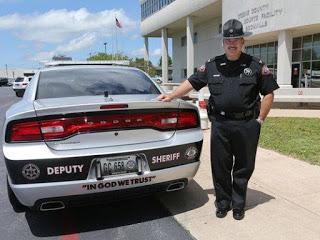
Sheriff Jim Arnott and a Greene County (Mo.) patrol car
(From missourifamily.org)
Is any of this remotely true? No, it isn't, and we can point to at least two key pieces of evidence to prove it.
The truth is that Carol's arm already was broken before she was placed in the patrol car. It was broken when three cops surrounded her as she was trying to enter our duplex apartment -- as she had been given permission to do -- to retrieve our cat's litter box. An officer in a blue shirt -- we cleverly call him "Mr. Blue Shirt" -- grabbed Carol from behind, around the shoulders, and slammed her butt-first to the ground. The impact of that body slam might have been enough to cause a concussion. But "Mr. Blue Shirt" (who is not nearly as pleasant as Mr. Blue Sky, of Electric Light Orchestra fame) was not finished inflicting damage. He then yanked on Carol's arms in an upward and backward direction, grabbing and twisting her arms just above the elbow.
That's when her arm was shattered, so severely that it required trauma surgery for repair; regular orthopedic work would not fix it. How do we know the "flailing" story is a steaming pile of excrement? Here is reason No. 1:
Carol was placed in a seat belt in the patrol car
Carol states unequivocally that cops used a seat belt -- with a shoulder harness -- when they placed her in the back seat of the patrol car. In other words, she was handcuffed with her arms behind her and restrained from her shoulders down. Try putting on handcuffs from behind, with a lap belt and shoulder harness, and see how much you can flail around in the back seat of your vehicle. You will find real quickly that you can't.
I was sitting in our car, which was parked close to the garage in our driveway of the duplex, when this happened. The patrol car was parked in the other driveway of the duplex, behind me and to my right, fairly close to the street. I lost sight of Carol as they put her in the backseat -- she was obscured partly by the vehicle itself and partly because, as I recall, its windows were tinted.
Two points are lodged in my memory as I read the officers' accounts: (1) My windows were rolled down, and I never heard Carol scream or curse at all. In fact, I never heard her cry out when her arm was broken, perhaps because she was in shock (paramedics later treated her with oxygen, which generally is applied to patients who show signs of going into shock) and perhaps because she already had suffered a concussion; (2) I remember, from my own experience being brutalized by cops in Shelby County, Alabama, that they belted me into the backseat to the point I felt like Hannibal Lecter. And that was while the vehicle was sitting still. I sat like that, with pepper spray dripping off of me, for roughly 20-30 minutes while an officer filled out a report before the car ever moved.
If you Google "prisoner transport and seat belts," you will find there has been litigation around the country about instances where prisoners or suspects were injured after officers failed to secure them with seat belts. (See here, here, and here.) Police agencies have paid out lots of money for failing to secure individuals riding in the back of patrol cars.
Our research indicates many police agencies have adopted policies that require officers to use seat belts whenever transporting prisoners or suspects. This is from page 745 of the policies and procedures manual of the Springfield (Mo.) Police Department, which is available online:
All prisoners transported in a police car shall be secured with a seat belt for their safety.
The manual for the Greene County (Mo.) Sheriff's Office disappeared online after I started writing about how the department's handling of Carol's case differed from official policy. We are in the process now of obtaining a hard copy of the manual, and my guess is that it includes a policy that requires officers to use seat belts when transporting prisoners.
If my guess about that is correct, it means the deputies not only are lying in their written statements, but they also violated departmental policy if they did not use a seat belt.
Either way, Carol is not the flailing type -- and she did not break her own arm in the backseat of a patrol car. We will address the second reason we know that in an upcoming post.
